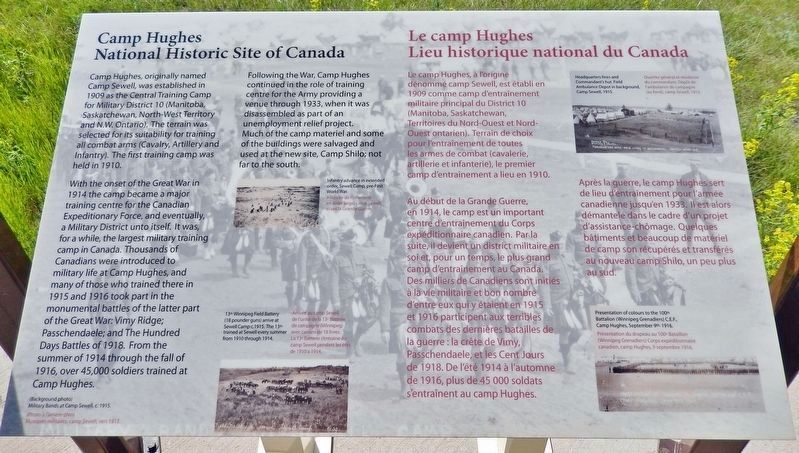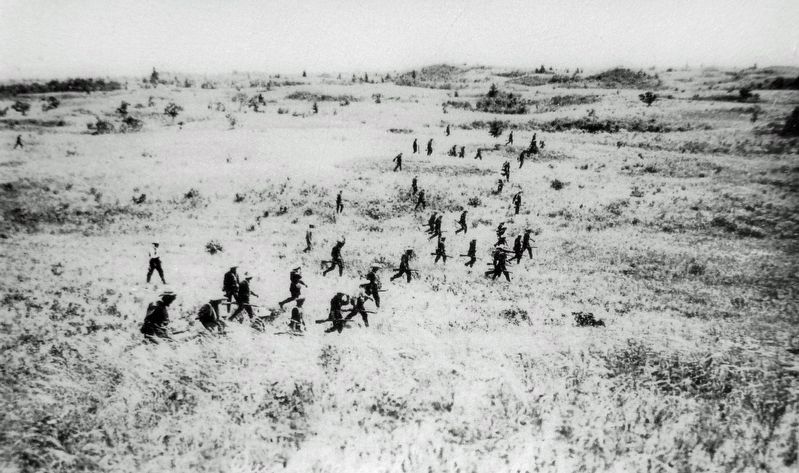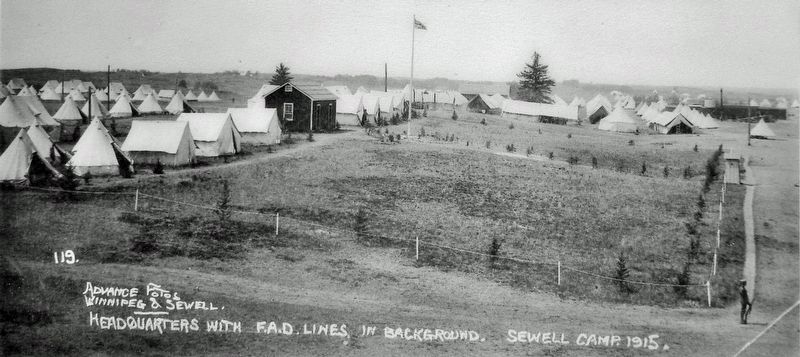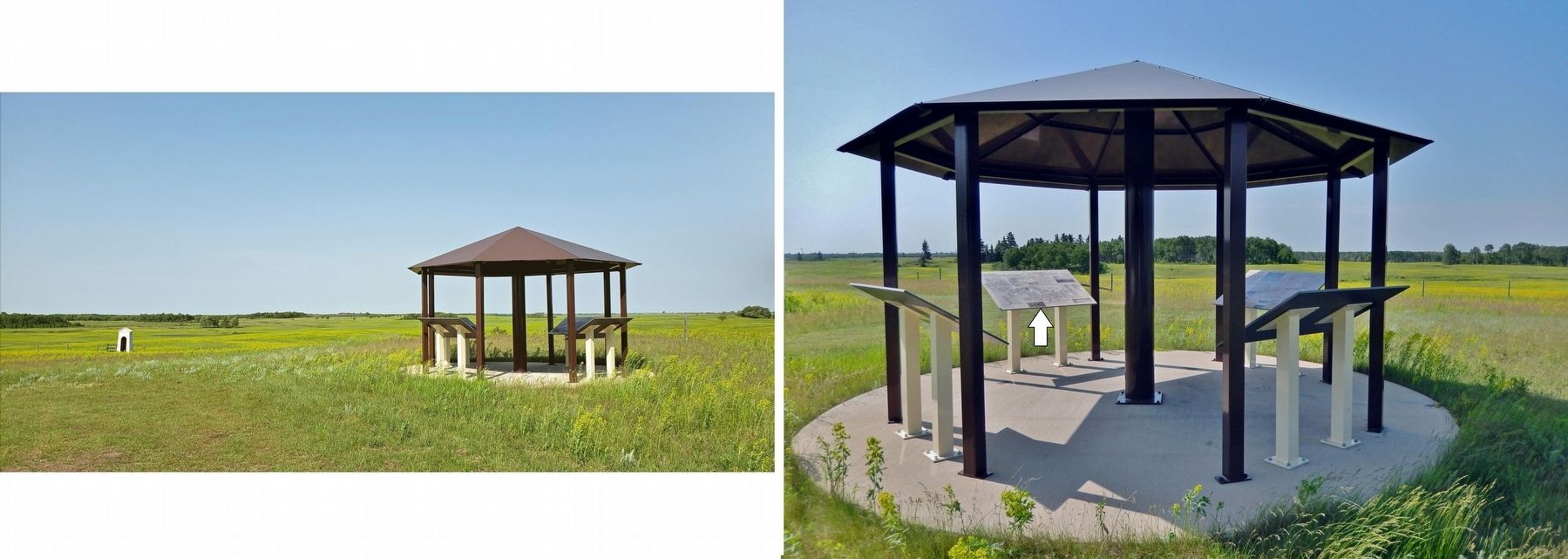Camp Hughes in North Cypress – Langford Municipality, Manitoba — Canada’s Prairie Region (North America)
Camp Hughes National Historic Site of Canada / Le camp Hughes Lieu historique national du Canada
Inscription.
With the onset of the Great War in 1914 the camp became a major training centre for the Canadian Expeditionary Force, and eventually, a Military District unto itself. It was, for a while, the largest military training camp in Canada. Thousands of Canadians were introduced to military life at Camp Hughes, and many of those who trained there in 1915 and 1916 took part in the monumental battles of the latter part of the Great War: Vimy Ridge; Passchendaele; and The Hundred Days Battles of 1918. From the summer of 1914 through the fall of 1916, over 45,000 soldiers trained at Camp Hughes.
Following the War, Camp Hughes continued in the role of training centre for the Army providing a venue through 1933, when it was disassembled as part of an unemployment relief project. Much of the camp materiel and some of the buildings were salvaged and used at the new site, Camp Shilo; not far to the south.
(Background photo)
Military Bands at Camp Sewell, c. 1915.
Au début de la Grande Guerre, en 1914, le camp est un important centre d'entraînement du Corps expéditionnaire canadien. Par la suite, il devient un district militaire en soi et, pour un temps, le plus grand camp d'entraînement au Canada. Des milliers de Canadiens sont initiés à la vie militaire et bon nombre d'entre eux qui y étaient en 1915 et 1916 participent aux terribles combats des dernières batailles de la guerre : la crête de Vimy, Passchendaele, et les Cent Jours de 1918. De l'été 1914 à l'automne de 1916, plus de 45 000 soldats s'entraînent au camp Hughes.
Après la guerre, le camp Hughes sert de lieu d'entraînement pour l'armée canadienne jusqu'en 1933. Il est alors démantelé dans le cadre d'un projet d'assistance-chômage. Quelques bâtiments et beaucoup de matériel
de camp son récupérés et transférés au nouveau camp Shilo, un peu plus au sud.
(Photo à l’arrière-plan)
Musiques militaires, camp Sewell, vers 1915.
Topics. This historical marker is listed in these topic lists: Cemeteries & Burial Sites • Education • Patriots & Patriotism • War, World I. A significant historical year for this entry is 1909.
Location. 49° 52.814′ N, 99° 33.444′ W. Marker is in Camp Hughes, Manitoba, in North Cypress – Langford Municipality. Marker can be reached from Camp Hughes Road (Road 91 W) 1.6 kilometers south of Provincial Road 351. Marker is located in the Camp Hughes National Historic Site interpretive kiosk, just west of the Camp Hughes Cemetery. Touch for map. Marker is in this post office area: Camp Hughes MB R0K 2A0, Canada. Touch for directions.
Other nearby markers. At least 8 other markers are within walking distance of this marker. Camp Life / La vie de camp (here, next to this marker); Trench Warfare / La guerre de tranchées (here, next to this marker); Training For War / L'entraînement de guerre (here, next to this marker); Camp Hughes (a few steps from this marker); Camp Hughes / Le Camp Hughes (a few steps from this marker); The Hospital / L'hôpital (approx. 0.4 kilometers away); Camp Hughes — Overview / Tour d'horizon du Camp Hughes (approx. 0.6
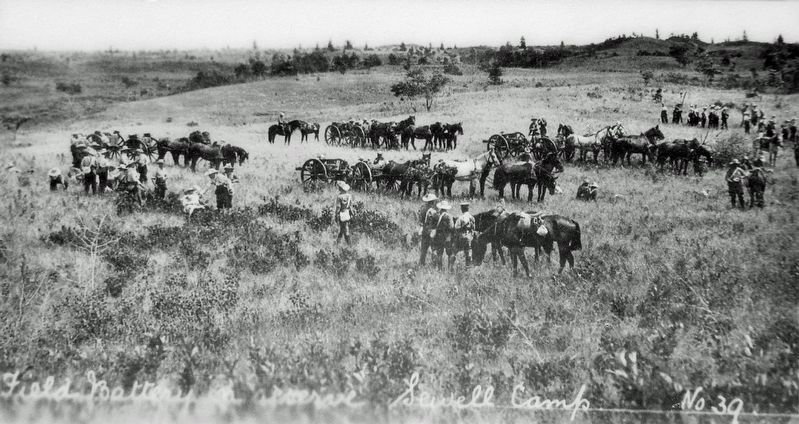
3. Marker detail: 13th Field Battery / 13e Batterie de campagne
13th Winnipeg Field Battery (18 pounder guns) arrive at Sewell Camp c.1915. The 13th trained at Sewell every summer from 1910 through 1914. ————— Arrivée au camp Sewell de l'unité de la 13e Batterie de campagne (Winnipeg) avec canons de 18 livres. La 13e Batterie s'entraîne au camp Sewell pendant les étés de 1910 à 1914.
Related markers. Click here for a list of markers that are related to this marker. Camp Hughes National Historic Site
Also see . . . Camp Hughes National Historic Site of Canada.
Camp Hughes National Historic Site of Canada is located south of the Trans-Canada Highway 10 kilometres west of Carberry, Manitoba. Formerly a First World War military training camp, it is one of the most intact simulated battlefield terrains in Canada. The site consists of rolling open grassy fields, remnants of the military camp consisting of administration and training areas, a cemetery and archaeological vestiges. Official recognition refers to the 420 hectare parcel of land including training trenches, rifle range, grenade training ground, artillery observation posts and a cemetery.(Submitted on March 24, 2023, by Cosmos Mariner of Cape Canaveral, Florida.)
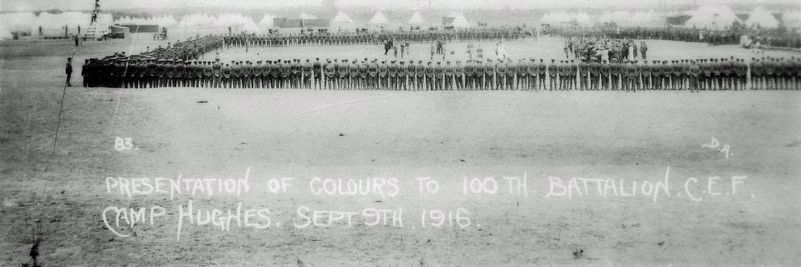
5. Marker detail: Presentation of colours / Présentation du drapeau
Presentation of colours to the 100th Battalion (Winnipeg Grenadiers) C.E.F., Camp Hughes, September 9th, 1916. ————— Présentation du drapeau au 100e Bataillon (Winnipeg Grenadiers) Corps expéditionnaire canadien, camp Hughes, 9 septembre 1916.
Credits. This page was last revised on March 24, 2023. It was originally submitted on March 23, 2023, by Cosmos Mariner of Cape Canaveral, Florida. This page has been viewed 82 times since then and 4 times this year. Photos: 1, 2, 3, 4, 5, 6. submitted on March 24, 2023, by Cosmos Mariner of Cape Canaveral, Florida.
